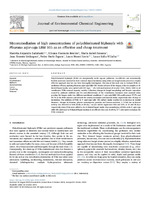Mycoremediation of high concentrations of polychlorinated biphenyls with Pleurotus sajor-caju LBM 105 as an effective and cheap treatment

Date
2019-10-22Author
Sadañoski, Marcela Alejandra
Benítez, Silvana Florencia
Fonseca, María Isabel
Velázquez, Juan Ernesto
Zapata, Pedro Darío
Levin, Laura Noemí
Villalba, Laura Lidia
Metadata
Show full item recordAbstract
Polychlorinated biphenyls (PCBs) are exceptionally stable organic pollutants. An effective and economically feasible process is essential for their removal. Mycoremediation using white-rot fungal strains proved as a highly effective approach that has not been thoroughly investigated. The aim of this work was to evaluate PCBs re-mediation efficacy applying Pleurotus sajor-caju LBM 105. Axenic cultures of the fungus, either in complex or N-limited liquid media, were spiked with 217 mg L−1 of a technical mixture of Aroclor 1242, 1254 y 1260 in oil transformer. PCBs removal capacity, toxicity reduction, changes in fungal morphology and laccase expression caused by pollutant addition and the cost-effectiveness of the remediation treatment were assessed when growing the fungus under two different nutritional conditions. P. sajor-caju LBM 105 could remove 97.7% and 91.7% of the PCBs mixture and reduced the toxicity in complex and mineral media respectively after 35 days of
incubation. The addition of PCBs to P. sajor-caju LBM 105 culture media resulted in an increase in hyphal diameter, changes in biomass, glucose consumption, proteins and laccase secretion. A 3-fold rise in laccase activity was detected in both media at 28 day. Laccase mRNA augmented 16% and 91% at 21 and 28 days respectively when PCBs were added to the N-limited liquid media. Mycoremediation of PCBs with P. sajor-caju LBM 105 cultivated in N-limited liquid medium is an effective low-cost (0.69 $ g-1d-1) alternative technique for PCBs treatment.
Collections
The following license files are associated with this item:



